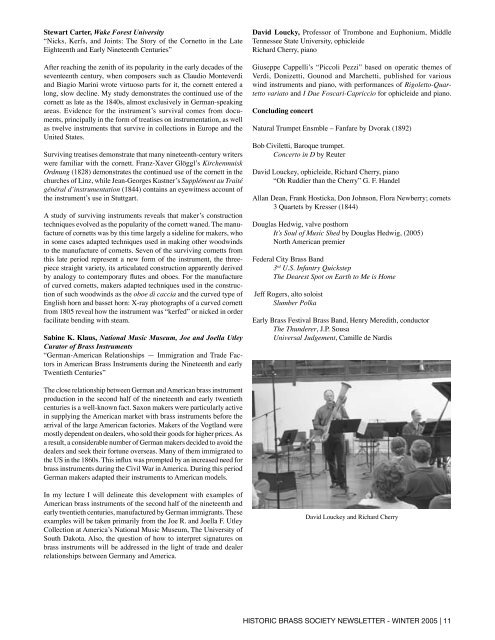18 News - Historic Brass Society
18 News - Historic Brass Society
18 News - Historic Brass Society
You also want an ePaper? Increase the reach of your titles
YUMPU automatically turns print PDFs into web optimized ePapers that Google loves.
Stewart Carter, Wake Forest University<br />
“Nicks, Kerfs, and Joints: The Story of the Cornetto in the Late<br />
Eighteenth and Early Nineteenth Centuries”<br />
After reaching the zenith of its popularity in the early decades of the<br />
seventeenth century, when composers such as Claudio Monteverdi<br />
and Biagio Marini wrote virtuoso parts for it, the cornett entered a<br />
long, slow decline. My study demonstrates the continued use of the<br />
cornett as late as the <strong>18</strong>40s, almost exclusively in German-speaking<br />
ments,<br />
principally in the form of treatises on instrumentation, as well<br />
as twelve instruments that survive in collections in Europe and the<br />
United States.<br />
Surviving treatises demonstrate that many nineteenth-century writers<br />
<br />
Ordnung (<strong>18</strong>28) demonstrates the continued use of the cornett in the<br />
<br />
(<strong>18</strong>44) contains an eyewitness account of<br />
<br />
<br />
techniques evolved as the popularity of the cornett waned. The manufacture<br />
of cornetts was by this time largely a sideline for makers, who<br />
in some cases adapted techniques used in making other woodwinds<br />
to the manufacture of cornetts. Seven of the surviving cornetts from<br />
this late period represent a new form of the instrument, the threepiece<br />
straight variety, its articulated construction apparently derived<br />
<br />
of curved cornetts, makers adapted techniques used in the construction<br />
of such woodwinds as the and the curved type of<br />
English horn and basset horn: X-ray photographs of a curved cornett<br />
from <strong>18</strong>05 reveal how the instrument was “kerfed” or nicked in order<br />
facilitate bending with steam.<br />
Sabine K. Klaus, National Music Museum, Joe and Joella Utley<br />
Curator of <strong>Brass</strong> Instruments<br />
“German-American Relationships — Immigration and Trade Factors<br />
in American <strong>Brass</strong> Instruments during the Nineteenth and early<br />
Twentieth Centuries”<br />
David Loucky, Professor of Trombone and Euphonium, Middle<br />
Tennessee State University, ophicleide<br />
Richard Cherry, piano<br />
<br />
Verdi, Donizetti, Gounod and Marchetti, published for various<br />
wind instruments and piano, with performances of -<br />
and for ophicleide and piano.<br />
Concluding concert<br />
Natural Trumpet Ensmble – Fanfare by Dvorak (<strong>18</strong>92)<br />
Bob Civiletti, Baroque trumpet.<br />
by Reuter<br />
David Louckey, ophicleide, Richard Cherry, piano<br />
“Oh Ruddier than the Cherry” G. F. Handel<br />
Allan Dean, Frank Hosticka, Don Johnson, Flora Newberry; cornets<br />
3 Quartets by Kresser (<strong>18</strong>44)<br />
Douglas Hedwig, valve posthorn<br />
by Douglas Hedwig, (2005)<br />
North American premier<br />
Federal City <strong>Brass</strong> Band<br />
3 rd <br />
<br />
Jeff Rogers, alto soloist<br />
<br />
Early <strong>Brass</strong> Festival <strong>Brass</strong> Band, Henry Meredith, conductor<br />
The Thunderer, J.P. Sousa<br />
, Camille de Nardis<br />
The close relationship between German and American brass instrument<br />
production in the second half of the nineteenth and early twentieth<br />
centuries is a well-known fact. Saxon makers were particularly active<br />
in supplying the American market with brass instruments before the<br />
arrival of the large American factories. Makers of the Vogtland were<br />
mostly dependent on dealers, who sold their goods for higher prices. As<br />
a result, a considerable number of German makers decided to avoid the<br />
dealers and seek their fortune overseas. Many of them immigrated to<br />
<br />
brass instruments during the Civil War in America. During this period<br />
German makers adapted their instruments to American models.<br />
In my lecture I will delineate this development with examples of<br />
American brass instruments of the second half of the nineteenth and<br />
early twentieth centuries, manufactured by German immigrants. These<br />
examples will be taken primarily from the Joe R. and Joella F. Utley<br />
<br />
South Dakota. Also, the question of how to interpret signatures on<br />
brass instruments will be addressed in the light of trade and dealer<br />
relationships between Germany and America.<br />
David Louckey and Richard Cherry<br />
HISTORIC BRASS SOCIETY NEWSLETTER - WINTER 2005 | 11
















